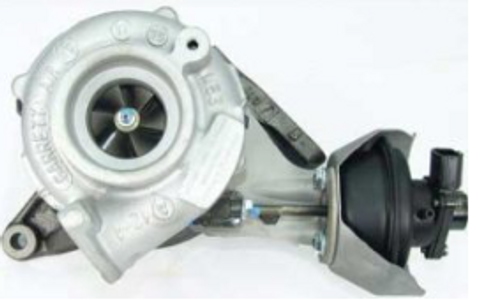Turbo Refurbishment: Keeping Engines Efficient for the Long Run
 Ayesha Alam
01 Sep, 2025
11 mins read
31
Ayesha Alam
01 Sep, 2025
11 mins read
31

Turbochargers are among the most important innovations in modern automotive engineering. They allow smaller engines to deliver the power of much larger ones while consuming less fuel and emitting fewer pollutants. For both private drivers and commercial fleets, turbos have become indispensable.
But despite their durability, turbochargers are not indestructible. Years of high heat, rapid rotations, and heavy loads inevitably take their toll. When a turbo begins to lose efficiency, owners are faced with a decision: replace it entirely or consider turbo refurbishment. For many, refurbishment represents a balanced option that restores performance, supports sustainability, and extends the life of a valuable component.
Understanding the Pressure Turbos Endure
The average turbocharger operates under extreme conditions. Exhaust gases at temperatures exceeding 900°C spin the turbine wheel, which in turn drives the compressor wheel to force more air into the engine. This process allows engines to burn fuel more efficiently and generate greater output.
However, with rotational speeds surpassing 100,000 RPM, even minor wear or imbalance can have a dramatic impact. Bearings may degrade, seals can lose effectiveness, and metal fatigue may develop in turbine housings. These issues gradually reduce efficiency and, if ignored, can lead to more serious engine problems.
What Is Turbo Refurbishment?
Turbo refurbishment is the process of restoring a worn turbocharger to a condition close to its original specifications. Unlike a basic repair that might only address one fault, refurbishment involves a complete evaluation of the unit, ensuring that performance, reliability, and emissions compliance are preserved.
For drivers, this means regaining the benefits of a turbocharged engine without the waste and environmental impact of discarding an entire unit. For industries, it means vehicles and machinery can remain productive while supporting broader sustainability goals.
Why Turbo Refurbishment Is Worth Considering
1. Restoring Engine Performance
When a turbo is refurbished, airflow and boost pressure can be brought back to expected levels. This translates into smoother acceleration, responsive throttle control, and improved fuel economy.
2. Extending Service Life
Refurbishment makes use of the core strength of the turbocharger while replacing or restoring parts that wear out. This extends the component’s operational lifespan, reducing the need for premature replacement.
3. Environmental Benefits
Discarded turbos add to waste and demand for raw materials. By refurbishing, the industry conserves metals and energy, lowering the overall carbon footprint associated with manufacturing new components.
4. Practicality for Fleets
For businesses running large fleets, refurbishment can be incorporated into maintenance strategies to keep vehicles efficient and compliant with emissions standards while minimizing downtime.
Signs That a Turbo May Need Refurbishment
While turbochargers are engineered for durability, drivers should pay attention to early warning signs that suggest refurbishment might be necessary:
- Loss of power: Noticeable reduction in acceleration and overall engine strength.
- Exhaust smoke: Blue, grey, or black smoke often points to oil leaks or inefficient combustion.
- Unusual noises: High-pitched whining, grinding, or rattling sounds may indicate imbalance or bearing wear.
- Increased oil use: A turbo consuming more oil than normal often signals problems with seals or lubrication.
- Warning lights: Modern vehicles may display error codes or dashboard lights linked to turbo performance.
Addressing these issues promptly allows for refurbishment to remain an option rather than facing total replacement.
Technical Demands of Refurbishment
Refurbishing a turbocharger requires precision. These machines are finely tuned, and even the smallest imperfection can cause performance issues or mechanical failure.
Key technical aspects include:
- Balancing: Turbine and compressor wheels must be perfectly aligned to prevent destructive vibrations at high speeds.
- Heat Stress Checks: Prolonged exposure to extreme heat can create microcracks or warping in the turbo housing.
- Bearings and Seals: These critical components wear down over time and must be restored to ensure proper lubrication and oil control.
- Variable Geometry Systems: Many modern turbos feature adjustable vanes that regulate airflow. Accurate calibration is essential to maintain efficiency and meet emissions requirements.
- Electronic Controls: Actuators and sensors must be inspected and verified to function in harmony with the vehicle’s engine control unit (ECU).
Because of these demands, refurbishment is not something that can be improvised — it requires professional expertise and specialized equipment.
The Wider Impact of Turbo Refurbishment
For Drivers
A refurbished turbo means continued driving comfort, responsive performance, and confidence that the vehicle remains efficient and reliable.
For Businesses
Fleet operators rely on predictable performance and low downtime. Refurbishment helps achieve these goals while managing long-term maintenance costs.
For the Environment
Refurbishment conserves resources, limits waste, and supports the shift toward a circular economy in the automotive industry.
Why Specialists Matter
Turbochargers are highly complex. The tolerances involved are microscopic, and the systems they interact with are critical to engine performance. Choosing the right expertise ensures refurbishment is carried out to the highest standards. For this reason, it’s always recommended to find a specialist near you who has the skills and equipment to restore a turbocharger safely and effectively.
The Future of Refurbishment
Turbocharger technology is advancing rapidly. Electrically assisted turbos, hybrid units, and advanced variable systems are already entering the market. As these technologies become widespread, refurbishment practices will evolve to meet their challenges.
In the future, refurbishment will not only involve restoring mechanical components but also integrating advanced diagnostics and electronic testing. This ensures that even the most sophisticated turbochargers can be kept in service rather than discarded prematurely.
Conclusion
Turbo refurbishment is a practical, sustainable, and performance-oriented solution for maintaining one of the most vital components in modern vehicles. It allows drivers and fleet operators to extend the life of their engines, conserve resources, and restore performance without unnecessary waste.
As vehicles become more dependent on turbochargers to deliver efficiency and meet regulatory demands, refurbishment will remain an essential part of keeping engines reliable and environmentally responsible. By choosing refurbishment, owners are not only preserving performance but also contributing to a more sustainable automotive future.
Written By:
Ayesha Alam



Hotels at your convenience
Now choose your stay according to your preference. From finding a place for your dream destination or a mere weekend getaway to business accommodations or brief stay, we have got you covered. Explore hotels as per your mood.





